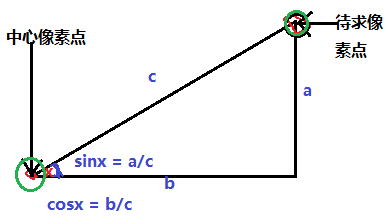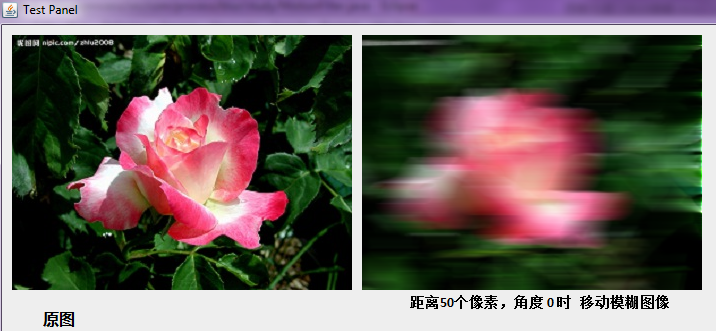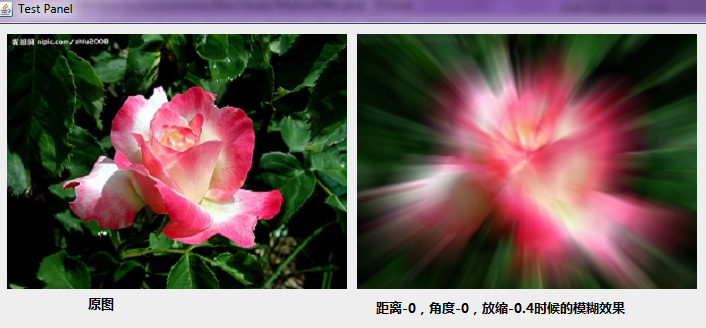- created by gloomyfish
卷积模糊或者卷积平滑滤波,可以消除图像噪声,也可以产生一些常见的图像模糊特效,但
是移动模糊特效也是基于卷积,相比于Box Blur, Gaussian Blur的算法,移动模糊只需要完成
一次的一维卷积,所不同的是一维卷积的完成,要基于一定的角度,而不是只是在水平和垂
直两个方向上。移动模糊的一维卷积要考虑一下三个因素:
a. 操作数的多少 - 即距离(Distance)
b.一维操作数在像素数组中的移动方向 – 即角度(Angle)
c.一维操作数的拉影效应 – 即Scale(放大和缩小程度)(Zoom/Scale)
距离和角度的关系可以用三角几何表示如下:

假设距离和角度已知的情知道中心点(目标像素点)则可以求出每个操作数的像素点坐标,假
设中心点坐标为Base(x0, y0) 则操作数P(a, b)坐标公式可以表示如下:
a = sinx * c +y0
b = cosx * c +x0
放缩功能其实是在XY两个方向对图像计算得到一个一维像素结合,再求这些像素的平均值
即可,假设中心点像素为x0, y0, 防缩比率为s0则每个操作数像素点坐标可以表示为:
a= x0-x0 * s0 + a
b= y0-y0*so + b
原理部分的解释大概如此,下面来看一下,实际图像处理效果和源代码详细解释。
程序运行效果如下– 距离50个像素,角度 0 时:

角度30时候的滤镜运行结果:

放缩模糊效果:

角度,距离,放缩三个参数综合效果:

关键代码解释:
计算三角几何角度sin与cos值的代码如下:
// calculate the trianglegeometry value float sinAngle = (float)Math.sin(angle/180.0f * onePI); float coseAngle = (float)Math.cos(angle/180.0f * onePI);
计算距离半径代码如下:
// calculate the distance,same as box blur float imageRadius = (float)Math.sqrt(cx*cx + cy*cy); float maxDistance = distance + imageRadius * zoom;
计算操作数像素坐标的代码如下:
// calculate the operatorsource pixel if(distance > 0) { newY = (int)Math.floor((newY+ i*sinAngle)); newX = (int)Math.floor((newX + i*coseAngle)); } 完成Scale的代码如下:
// scale the pixels float scale = 1-zoom*f; m11 = cx - cx*scale; m22 = cy - cy*scale; newY = (int)(newY * scale +m22); newX = (int)(newX * scale + m11);
求取像素平均值,完成一维卷积的代码如下:
// blur the pixels, here count++; int rgb= inPixels[newY*width+newX]; ta += (rgb >> 24) & 0xff; tr += (rgb >> 16) & 0xff; tg += (rgb >> 8) & 0xff; tb += rgb & 0xff;
重新填充目标像素的代码如下:
ta = clamp((int)(ta/count)); tr = clamp((int)(tr/count)); tg = clamp((int)(tg/count)); tb = clamp((int)(tb/count)); outPixels[index] = (ta << 24) | (tr<< 16) | (tg << 8) | tb;
移动模糊算法的完全源代码如下(不包含测试代码):
package com.gloomyfish.process.blur.study; import java.awt.image.BufferedImage; public class MotionFilter { private float distance = 0;// default; private float onePI = (float)Math.PI; private float angle = 0.0f; private float zoom = 0.4f; public float getDistance() { return distance; } public void setDistance(float distance) { this.distance = distance; } public float getAngle() { return angle; } public void setAngle(float angle) { this.angle = angle; } public BufferedImage filter(BufferedImage src, BufferedImage dst) { int width = src.getWidth(); int height = src.getHeight(); if ( dst == null ) dst = createCompatibleDestImage( src, null ); int[] inPixels = new int[width*height]; int[] outPixels = new int[width*height]; getRGB( src, 0, 0, width, height, inPixels ); int index = 0; int cx = width/2; int cy = height/2; // calculate the triangle geometry value float sinAngle = (float)Math.sin(angle/180.0f * onePI); float coseAngle = (float)Math.cos(angle/180.0f * onePI); // calculate the distance, same as box blur float imageRadius = (float)Math.sqrt(cx*cx + cy*cy); float maxDistance = distance + imageRadius * zoom; int iteration = (int)maxDistance; for(int row=0; row<height; row++) { int ta = 0, tr = 0, tg = 0, tb = 0; for(int col=0; col<width; col++) { int newX= col, count = 0; int newY = row; // iterate the source pixels according to distance float m11 = 0.0f, m22 = 0.0f; for(int i=0; i<iteration; i++) { newX = col; newY = row; // calculate the operator source pixel if(distance > 0) { newY = (int)Math.floor((newY + i*sinAngle)); newX = (int)Math.floor((newX + i*coseAngle)); } float f = (float)i/iteration; if (newX < 0 || newX >= width) { break; } if (newY < 0 || newY >= height) { break; } // scale the pixels float scale = 1-zoom*f; m11 = cx - cx*scale; m22 = cy - cy*scale; newY = (int)(newY * scale + m22); newX = (int)(newX * scale + m11); // blur the pixels, here count++; int rgb = inPixels[newY*width+newX]; ta += (rgb >> 24) & 0xff; tr += (rgb >> 16) & 0xff; tg += (rgb >> 8) & 0xff; tb += rgb & 0xff; } // fill the destination pixel with final RGB value if (count == 0) { outPixels[index] = inPixels[index]; } else { ta = clamp((int)(ta/count)); tr = clamp((int)(tr/count)); tg = clamp((int)(tg/count)); tb = clamp((int)(tb/count)); outPixels[index] = (ta << 24) | (tr << 16) | (tg << 8) | tb; } index++; } } setRGB( dst, 0, 0, width, height, outPixels ); return dst; } public int clamp(int c) { if (c < 0) return 0; if (c > 255) return 255; return c; } }后记:本滤镜的基点即中心像素,是可以调整的。 感兴趣的可以自己完成,转载文章请务必注明出自本博客


















